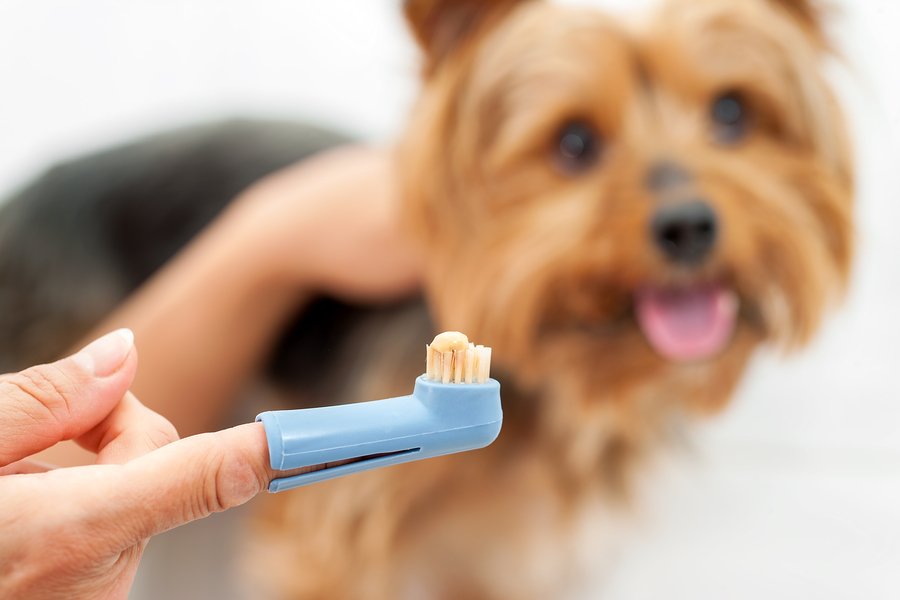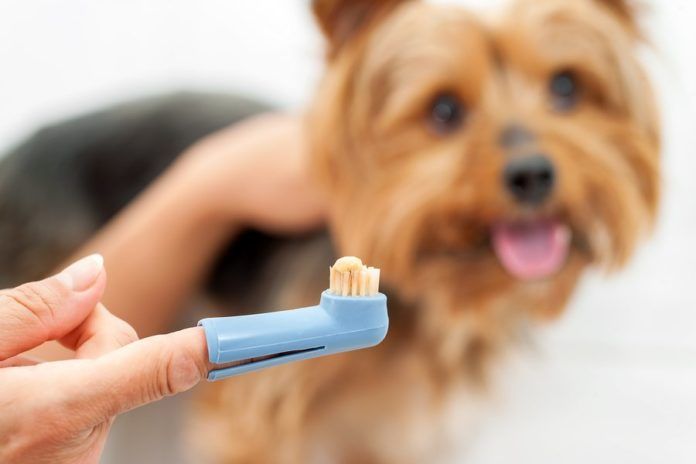© karelnoppe | Bigstock

“When I see a patient and take a history from the owner, asking ‘How often do you brush your dog’s teeth?’ I get responses like ‘Oh, you need to brush their teeth?’ Or ‘My groomer does it when he goes in for grooming,'” says board-certified veterinary dentist Bonnie Shope, VMD, past chair of the American Veterinary Dental College’s Examination Committee and Training Support Committee. “Sometimes they expect kudos when they respond that they brush their pet’s teeth once a month.”
They also have misconceptions about what proper teeth brushing looks like, Dr. Shope says, how it helps a dog stay healthy, and the role of treats made of bones and other hard chews in a dog’s oral hygiene. Herewith, the common myths about taking care of your dog’s teeth — and the right way to do it.
1. Routine teeth brushing is not essential. “We really want people brushing their dog’s teeth every day,” Dr. Shope says. “It doesn’t have to be twice a day, like with people. But once a day is important.” Why?
Brushing removes plaque, which forms on the teeth’s surface every single day — within hours, in fact.It’s a thick substance that is 80 percent bacteria and smaller parts saliva and food particles. “And it is what the body’s immune system reacts to,” Dr. Shope says. “If you don’t remove plaque and it keeps piling up, the gums become inflamed, red, swollen. That’s gingivitis — the beginning of gum disease, and over time we’ll see it destroy gum and bone tissue. The gum recedes, bone is lost, and in some dogs, they lose teeth.”
2. If you don’t brush every day, you can still remove the plaque build-up every few days. Plaque is a soft bio-film that sticks to the teeth but is very easy to dislodge when scrubbed with a toothbrush, Dr. Shope explains. The problem is that if it sits there for even just two or three days, it begins to mineralize into multiple layers and turn from plaque into tartar, also known as calculus. A brownish-yellow color, “tartar is like cement,” the doctor says. “It’s rock hard. You can’t brush it away,” so it sits there acting as an irritant. Worse still, plaque loves to stick to tartar. In other words, plaque that doesn’t get brushed away and turns into tartar creates an ideal environment for even more plaque to accumulate and for its destructive bacteria to do their dirty work.
3. I feed my dog a diet that the label says is good for her teeth, so I don’t have to brush. There are dental diets for dogs that help clean the teeth by reducing tartar build-up, which in turn helps reduce more plaque build-up. And if you go to the website of the Veterinary Oral Health Council at www.vohc.org, you can find diets and dog treats that have received a seal of approval by a council of veterinary dentists and researchers who have reviewed the evidence for these products’ effectiveness. But brushing remains the gold standard, Dr. Shope says. Nothing can replace it. These products are only adjuncts to daily brushing of your dog’s teeth.
4. You only have to brush the outside of the teeth. Brushing just the outside (the cheek side) is certainly better than brushing no side, “and it’s certainly easier,” Dr. Shope says. “But we encourage clients to brush the inside surfaces as well. The best way to do it is to approach with the toothbrush coming from the front of the mouth. If you try to come from the side, the dog will just bite down on the toothbrush. It’s a simple trick, but it works.”
5. Giving your dog bones and other hard things to chew is good for her teeth. “A bone might help clean the teeth,” Dr. Shope says, but at the same time “it’s really destructive and can cause tooth fractures. The harm is worse than the help.” It’s not just bones that are thought to be healthful for the teeth but actually cause more harm than good. “The common things we see that damage teeth include antlers, hooves, ice cubes, hard nylon toys, and Himalayan milk chews, or yak chews,” she reports.
6. Fractured or discolored teeth may be unsightly but don’t cause a dog any harm or pain. “Even some veterinarians think fractured teeth don’t bother a dog and tell clients just to keep an eye on it,” Dr. Shope says. After all, “a dog will often keep eating. She won’t complain. It’s not like a limp, or throwing up that clearly needs attention.” The problem, the doctor notes, is that by the time a dog has a problem that’s apparent to the owner, “the tooth is severely infected and the dog has been suffering for years. We have to do a root canal or extract the tooth. I’m not talking about a chip in the enamel,” she makes clear, “but a fracture that’s severe enough to expose the pulp.”
It’s the same with a tooth that becomes discolored and is now purple or pink or grey. It’s not just unsightly. “Those are dead teeth,” Dr. Shope explains, “and they’re prone to getting infected and having painful abscesses.”





